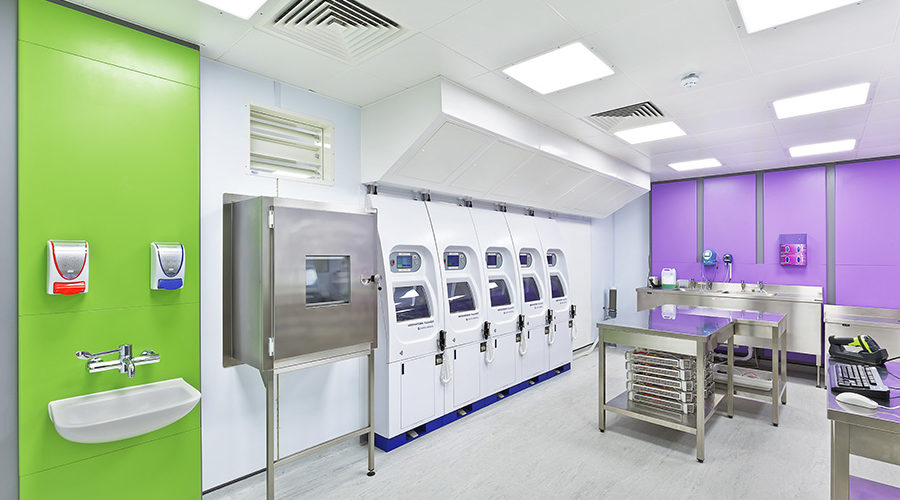MTX Contracts explores why designers and contractors in the modular healthcare sector should go above and beyond the minimum standards of ventilation and what is deemed ‘adequate’.
MTX Contracts
Ventilation is a critical tool to protect both patients and healthcare staff from the spread of potentially harmful airborne pathogens. Infection prevention and control is vital in healthcare settings at any time, but this has been a key focus during the course of the COVID-19 pandemic.
One primary area of concern is ensuring the appropriate ventilation of modular buildings. Many buildings are supplied with no mechanical ventilation or air-handling system, and whilst that may be considered adequate in meeting minimum standards, it shouldn’t be deemed appropriate, as the world has changed following the pandemic.
Increasing insights and scientific evidence collected over the course of the COVID-19 pandemic indicates that the highest risk of virus transmission is often over short ranges and within enclosed environments.
In addition to airborne transmission of COVID-19 and the virus transmitting directly between people during physical contact, there is also evidence that people situated in poorly ventilated spaces have a greater risk of infection.
Additionally, people are at their most contagious when they are largely asymptomatic, so it becomes increasingly important to consider ventilation of not only clinical spaces which are housing patients, but the accommodation of hospital staff also.
However, there is concern in the modular sector that the drive to get the best value can result in a lack of consideration for patient comfort, infection control and, most importantly, patient care. This is particularly the case of recent times with high levels of demand and pressure to reduce the NHS backlog.
Professor Cath Noakes from the School of Civil Engineering at the University of Leeds is leading research into ventilation, indoor air quality and infection control in the built environment.
Noakes addressed the virtual Healthcare Estates Conference in October 2020 on the issue of ventilation. She suggested that airborne aerosol particles need drag force to keep them up and gravity to bring them down. But air velocity in a room is known to impact on this and various-sized particles can remain in the air for a significant amount of time, often travelling far from their original source.
This is where ventilation of clean air can have a significant impact. If a space is well ventilated, it is more difficult to completely contain the virus, however the ventilation will mitigate the virus significantly and reduce the risk of infection.
This is echoed in the Federation of European Heating, Ventilation and Air Conditioning Association’s REHVA COVID-19 Guidance Document, which describes ventilation as the principal engineering control to help regulate infection, therefore highlighting the key role ventilation plays in the COVID-19 response effort.
Although, the standard specification of modular buildings does not include mechanical ventilation, compliance with HTM 03-01 simply means that the contractor has met the minimum standards required. In addition, as with any natural ventilation method, the airflow and air change rates cannot be guaranteed as they are subject to external factors such as wind speed, direction and pressure.
The HTM 03-01 standards, originally released in 2007, have since been updated this year, however these standards still fail to acknowledge the latest development and innovation of MMC and the necessity of clean air design within modular buildings. The HTM 03-01 standards do not mention the requirements for ventilation design to be discussed with the trust’s ventilation safety group, which further puts the wellbeing of patients and staff at risk.
When the standards were initially published, the use of modular buildings was very limited, but now they are seen as an essential tool for increasing healthcare facilities.
Reflective of the pandemic, the newest HTM 03-01 standard sees an increase in minimum requirements for ventilation systems to address the importance of clean airflow paths in healthcare environments.
David Hartley, Managing Director of MTX, a leading healthcare MMC specialist, shares his thoughts on how he thinks the COVID-19 pandemic will affect the future of modular building design in this sector.
“At MTX, we recognise the importance of engineering air movement and clean airflow pathways within modular buildings – particularly those housing patients. Those factors are a vital consideration for our engineers when assessing the performance of the buildings we provide for health trusts and hospitals. We have the technical expertise and experience to work with clinicians and facilities teams to ensure the building is fit for purpose in every case.
“Optimum airflow is accepted as an important factor in the health, wellbeing and comfort of patients and staff. It is much more difficult and expensive to retrofit air-handling systems to modular units, which is why it is so important to give it full consideration at the design and build stages.
“It is not ‘one-size-fits-all’. For example, people who deliver a building in just a few short weeks may be working hard to fulfil a need – but the building they produce may be a basic shell, which could as easily be a schoolroom or an office. Modular buildings used for patient care should be specifically designed and engineered for healthcare use.
“Taking into account the threat from COVID-19, it is apparent that more attention needs to be paid to ensuring mechanical ventilation is considered in every case when designing and creating modular buildings.”









